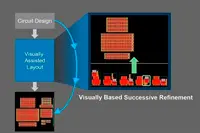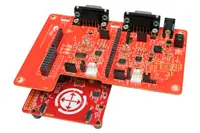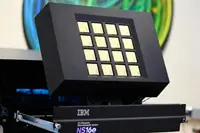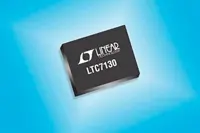Electronics News
Archive : 30 March 2016 год
 Synopsys has launched Custom Compiler, a design solution intended to close what the company calls a FinFET productivity gap.
Synopsys has launched Custom Compiler, a design solution intended to close what the company calls a FinFET productivity gap.
Dave Reed, director of marketing for Synopsys’ mixed signal and analogue group, noted that, as companies move to FinFET based designs, productivity has declined by up to a factor of three. “Companies are moving to FinFET based designs, but as they move, they get an ‘eye opening’ experience,” he said.
While analogue functionality isn’t necessarily suited to FinFET transistors, Reed said the trend towards SoCs meant analogue designers were compelled to use the latest process nodes.
“FinFETs have complicated series and parallel stacks,” he pointed out. “Because layout is inflexible, the cost of mistakes is high and there is a threefold increase in layout effort. The productivity gap is becoming an important issue to solve.”
Looking to address the issue, Synopsys has developed what it calls visually assisted automation technologies that are intended to speed common design tasks, reduce iterations and enable reuse.
Custom Compiler features four so called Assistants: graphical based productivity aids that are familiar to layout designers and which avoid the need to write code and constraints.
Layout Assistants provide visually guided automation of placement and routing and are said to be suitable for connecting FinFET arrays or large-M factor transistors. In-Design Assistants reduce design iterations by catching physical and electrical errors before signoff verification. Template Assistants help designers to apply previous layout decisions to new designs, while Co-Design Assistants combine IC Compiler and Custom Compiler into a unified solution for custom and digital implementation.
Custom Compiler has been used internally by Synopsys since mid 2015. “We’ve been using it to build IP for the 10nm node,” Reed said. “We’ve measured the results and found the typical cell creation time was reduced from one hour to five minutes.”
Reed also noted the solution was not only focused at FinFET based designs. “It’s compelling for analogue designers working, for example, on FD-SOI based products.”
Custom Compiler is already in use for production work on the most advanced nodes and is supported on FinFET process technologies by leading foundries. Other early adopters include STMicroelectronics and memory developer GSI.
Pic: Custom Complier feature visually assisted automation
Author
Graham Pitcher
Source: www.newelectronics.co.uk
 Cypress has released a kit that enables designers to evaluate the Controller Area Network (CAN) and Local Interconnect Network (LIN) slave communication capability of Cypress’s PSoC programmable system-on-chip and Flexible Microcontroller (MCU) families. The kit features two CAN transceivers, two LIN transceivers and Arduino compatible headers.
Cypress has released a kit that enables designers to evaluate the Controller Area Network (CAN) and Local Interconnect Network (LIN) slave communication capability of Cypress’s PSoC programmable system-on-chip and Flexible Microcontroller (MCU) families. The kit features two CAN transceivers, two LIN transceivers and Arduino compatible headers.
The CY8CKIT-026 CAN and LIN Shield Kit enables designers to create their own projects with easy-to-use CAN and LIN slave components in Cypress’s PSoC Creator Integrated Design Environment (IDE) or by altering code examples provided with this kit. The IDE is said to simplify system design and accelerate time-to-market by enabling concurrent hardware and firmware design. PSoC Creator works with PSoC Components to enable rapid prototyping of end applications while minimising PCB redesigns and firmware changes.
The kit’s Arduino-compatible shield board can be used with Cypress’s CY8CKIT-042 PSoC 4 Pioneer Kit and CY8CKIT-044 PSoC 4 M-Series Pioneer Kit. The kit’s CAN code example demonstrates how to send and receive data over the CAN bus using a capacitive touch-sensing button implemented with CapSense technology. The status of the button on the Pioneer kit is sent using the CAN protocol to control LEDs at the CAN receiver. This code example demonstrates the configuration and use of the CAN Transmit and CAN Receive mailboxes. The kit’s LIN code examples demonstrate the implementation of LIN slave communication in PSoC 4. The LIN component in PSoC 4 supports a LIN slave with both LIN v1.3 and LIN v2.1/2.2 protocol specifications.
Author
Tom Austin-Morgan
Source: www.newelectronics.co.uk
 Lawrence Livermore National Laboratory (LLNL) has purchased a first-of-a-kind brain-inspired supercomputing platform for deep learning inference developed by IBM Research. Based on a breakthrough neurosynaptic computer chip called IBM TrueNorth, the scalable platform will process the equivalent of 16million neurons and 4billion synapses and consume the energy equivalent of a tablet computer – 2.5W of power for the 16 TrueNorth chips.
Lawrence Livermore National Laboratory (LLNL) has purchased a first-of-a-kind brain-inspired supercomputing platform for deep learning inference developed by IBM Research. Based on a breakthrough neurosynaptic computer chip called IBM TrueNorth, the scalable platform will process the equivalent of 16million neurons and 4billion synapses and consume the energy equivalent of a tablet computer – 2.5W of power for the 16 TrueNorth chips.
The brain-like, neural network design of the IBM Neuromorphic System is able to infer complex cognitive tasks such as pattern recognition and integrated sensory processing more efficiently than conventional chips.
The system will be used to explore computing capabilities important to the National Nuclear Security Administration’s (NNSA) missions in cyber security, stewardship of the US nuclear deterrent and non-proliferation. NNSA’s Advanced Simulation and Computing (ASC) program will evaluate machine learning applications, deep learning algorithms and architectures and conduct general computing feasibility studies.
“Neuromorphic computing opens very exciting new possibilities and is consistent with what we see as the future of the high performance computing and simulation at the heart of our national security missions,” said Jim Brase, LLNL deputy associate director for Data Science. “The potential capabilities neuromorphic computing represents and the machine intelligence that these will enable will change how we do science.”
The technology represents a fundamental departure from computer design that has been prevalent for the past 70 years and could be a powerful complement in the development of next-generation supercomputers able to perform at exascale speeds, 50 times faster than today’s most advanced petaflop systems.
Michel McCoy, LLNL programme director for Weapon Simulation and Computing, said: “The low power consumption of these brain-inspired processors reflects the industry’s desire and a creative approach to reducing power consumption in all components for future systems as we set our sights on exascale computing.”
“The delivery of this advanced computing platform represents a major milestone as we enter the next era of cognitive computing,” said Dharmendra Modha, chief scientist, brain-inspired computing, IBMResearch. “This collaboration will push the boundaries of brain-inspired computing to enable future systems that deliver unprecedented capability and throughput, while helping to minimise the capital, operating and programming costs.”
Author
Tom Austin-Morgan
Source: www.newelectronics.co.uk
 Linear Technology has introduced the LTC7130, a constant frequency peak current mode synchronous step-down DC/DC converter with temperature-compensated ultralow DCR current sensing and clock synchronisation. With an input range of 4.5 to 20V the device is claimed to support a variety of applications, including most intermediate bus voltages, is compatible with many battery types and offers efficiency of up to 95%
Linear Technology has introduced the LTC7130, a constant frequency peak current mode synchronous step-down DC/DC converter with temperature-compensated ultralow DCR current sensing and clock synchronisation. With an input range of 4.5 to 20V the device is claimed to support a variety of applications, including most intermediate bus voltages, is compatible with many battery types and offers efficiency of up to 95%
Integrated N-channel MOSFETs can deliver continuous load currents as high as 20A at output voltages ranging from 0.6 to 5.5V, making it ideal for point-of-load applications such as high current / low voltage DSP / FPGA / ASIC reference designs. Other applications include telecom/datacom systems, distributed power architectures and general high power density systems.
The device’s architecture is said to ease compensation and offer the ability to directly parallel multiple ICs for higher current capability. It also enhances the signal-to-noise ratio of the current sense signal, enabling the use of a low DC resistance power inductor to maximise efficiency in high current applications. This feature is also claimed to reduce the switching jitter commonly found in low DCR applications and improves current limit accuracy.
The LTC7130’s 90ns minimum on-time allows for a high step-down ratio power supply at high frequency operation. The operating frequency is selectable from 250 to 770kHz and can be synchronised to an external clock. Additional features include a high speed differential remote sense amplifier, programmable output current limit, output short-circuit protection with soft recovery, programmable soft-start/tracking, EXTVCC for reduced power dissipation and a fault indicator for output UV/OV conditions.
The LTC7130 is available in a thermally enhanced 6.25mm × 7.5mm × 2.22mm BGA package, with both RoHS lead-free and leaded SnPb finishes and operates across a junction temperature range from -40 to 125°C.
Author
Tom Austin-Morgan
Source: www.newelectronics.co.uk
 Synaptics has announced a family of feature-rich touch controller solutions designed for the automotive market. The ClearPad automotive solutions include S7883, S7884, S7885, and S7886. The S7883/4 feature 80 channels and the S7884/6 feature 102 channels and are claimed to enable touchscreens up to 14 inches and an industry-leading 17 inches respectively.
Synaptics has announced a family of feature-rich touch controller solutions designed for the automotive market. The ClearPad automotive solutions include S7883, S7884, S7885, and S7886. The S7883/4 feature 80 channels and the S7884/6 feature 102 channels and are claimed to enable touchscreens up to 14 inches and an industry-leading 17 inches respectively.
The ClearPad S788x family of touch controllers detect proximity, and are claimed to perform while the operator is wearing gloves and under moist screen or finger conditions. Additionally, the S7884/6 products feature Synaptics’ ClearForce pressure sensing technology, enabling variable force to power unique touchscreen features specified by OEMs and their Tier 1 suppliers.
The range also incorporates Synaptics’ Natural ID fingerprint sensors that provide biometric security for vehicle access and personalisation of settings on infotainment screens or instrument clusters.
John Brady, senior director, product marketing, Smart Display Division, Synaptics, said: “We are thrilled to help shape the future of human interface in the automotive as the industry rapidly changes.”
Synaptics’ range is said to meet ISO 11452 standards for automotive electromagnetic compatibility (EMC), Automotive Electronics Council (AEC-Q100) specifications for use in harsh automotive environments, and are PPAP compliant. Synaptics is QMS certified to ISO 9001 with a TS-16949 compliant supply chain.
Author
Tom Austin-Morgan
Source: www.newelectronics.co.uk

